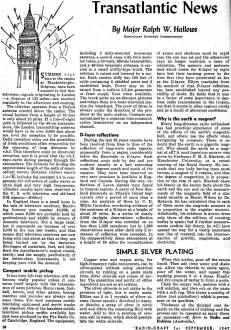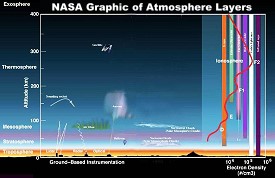|
September 1947 Radio-Craft
 [Table of Contents] [Table of Contents]
Wax nostalgic about and learn from the history of early electronics.
See articles from Radio-Craft,
published 1929 - 1953. All copyrights are hereby acknowledged.
|
"Transatlantic News" was a
regular column in the 1940 issues of Radio-Craft magazine, written by their
European correspondent Major Ralph Hallows. As the title suggests, it reported on
happenings from across the pond. A couple items caught my attention in this edition.
One is about one of the first instances of the prediction of existence of a
D-Layer in the ionosphere
based on radio signal propagation characteristics noted by operators. The article
estimates a height of about 30 miles, while the modern definition of the D-Layer
places it at between 60 km (37 mi) to 90 km (56 mi). It also has a piece describing
a simple method for silver plating without the need for supplying an electrical
current. It involves making a paste of
silver chloride and
cream of tartar
(potassium bitartrate) and rubbing it on the target metal. Supposedly the bond is
as durable as electroplating.
Transatlantic News
 By Major Ralph W. Hallows By Major Ralph W. Hallows
Radio-Craft European Correspondent
 D-Layer
Reflections D-Layer
Reflections
During the last 20 years reports have been received from time to time of the
reflection of long-wave radio signals, apparently from a region considerably below
the Heaviside or E-Layer. Such reflections occur only by day and are confined usually
to a belt extending some 30 degrees north and south of the equator. They have been
observed on very rare occasions in localities in England and Canada. During the
war, reflections of Loran signals were found in tropical regions. A party of New
Zealand physicists on Pitcairn Island kept records over a period of more than a
year. An analysis of these by C. D. Ellyet furnishes convincing, evidence of the
existence of a D-layer at a height of about 30 miles. In a series of nearly 2,000
daylight observations reflection from the D-layer was recorded on no less than 1,302
occasions; but in 1,200 observations made after dark only 2 instances of reflection
were recorded. In the comparatively dense atmosphere at a height of 50 miles the
recombination of atoms and electrons must be rapid once the sun has set and the
ultraviolet rays no longer maintain a state of ionization. The meteors and meteoric
dust which ionize the E-layer by night have lost their ionizing power by the time
that they have penetrated as far as the D-layer. Ellyet concludes from his analysis
of that D-layer reflection has been established beyond any possibility of doubt.
He holds that it may be a factor of some importance in daytime radio transmission
in the tropics, but that it occurs in other regions rarely and as a result of abnormal
conditions.
Simple Silver Plating
Copper wire and copper strip, for high-frequency radio components, can be silver-plated
without using electrical circuits by rubbing on a paste made from silver chloride
and cream of tartar. The quantities and purity of either ingredient are not at all
critical.
The silver chloride is not stable in the presence of light, but is easily made.
Either use 2 or 3 crystals of silver nitrate (lunar caustic) dissolved in water,
or dissolve a scrap of silver in nitric acid and dilute the remaining fluid with
water. Add to this a solution, of common salt in water, which should precipitate
the white chloride.
When this settles, pour off the excess liquid. Then add clean water and shake
up. Allow the chloride to settle again, pour off the water, and repeat this washing
process 3 or 4 times. Finally add dry cream of tartar to form a paste.
Clean the' copper well, moisten with a salt solution, and then rub on the paste
with a soft rag. This forms a coating of silver (not quicksilver) which is permanent
in its qualities.
Thickness of the finished coat depends on the amount of rubbing and the process
can be repeated as many times as necessary. - R. Kerr in Radio and Hobbies (Australia).
Posted July 2, 2020
|











